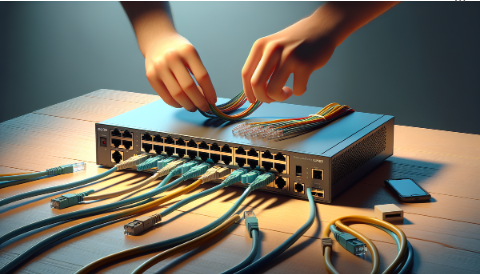Master Network Configuration: How to Effectively Set Up a Managed IP Switch

Setting up a managed IP switch
Generally, using a managed IP switch allows you to configure a wide range of parameters to control network performance, security, and management. Below are the key categories and some specific parameters you can set up:
1. Basic Configuration
- IP Address and Subnet Mask: Assign a static IP address to the switch for management purposes.
- Default Gateway: Configure the gateway IP address for communication outside the local network.
- Hostname: Set a unique name for the switch.
- VLAN Creation: Define and create VLANs.
- Port VLAN Membership: Assign specific ports to VLANs.
- VLAN Tagging: Configure 802.1Q tagging on ports.
- VLAN Trunking: Set up trunk ports to carry traffic for multiple VLANs.
- Port Speed and Duplex: Set the speed (e.g., 10/100/1000 Mbps) and duplex mode (half/full) for each port.
- Port Mirroring: Duplicate the traffic on one port to another for monitoring purposes.
- Port Security: Restrict access based on MAC addresses.
- Link Aggregation (LAG): Combine multiple ports to work as a single logical link for increased bandwidth.
- Traffic Prioritization: Prioritize traffic based on parameters like IP address, VLAN, or protocol.
- Bandwidth Limiting: Control the bandwidth usage per port or per traffic type.
- Queue Management: Set up different queues for traffic handling.
- Access Control Lists (ACLs): Define rules to control incoming and outgoing traffic.
- MAC Address Filtering: Allow or block devices based on MAC addresses.
- 802.1X Authentication: Enable port-based network access control.
- DHCP Snooping: Prevent unauthorized DHCP servers from distributing IP addresses.
- IP Source Guard: Block spoofed IP addresses.
- STP/RSTP/MSTP Configuration: Prevent network loops by configuring the Spanning Tree Protocol.
- Root Bridge Selection: Set priorities to influence the root bridge election.
- Static Routing: Define static routes to direct traffic to specific paths.
- Dynamic Routing Protocols: Configure protocols like RIP, OSPF, or BGP if supported.
- SNMP Configuration: Enable and configure Simple Network Management Protocol for monitoring.
- Syslog: Set up logging of events to a syslog server.
- sFlow/NetFlow: Enable flow monitoring for traffic analysis.
- Firmware Updates: Upload and apply new firmware versions.
- Backup and Restore: Save and restore configuration settings.
- LLDP Configuration: Enable LLDP to discover and map the network topology.
- EEE (Energy Efficient Ethernet): Enable settings to reduce power consumption.
By configuring these parameters, you can tailor the managed IP switch to meet the specific needs of your network, ensuring optimal performance, security, and manageability.
Tags
bas
ot
bas network
control panels
network configuration
port security
network control
smart buildings
energy management
building automation
ethernet based
bas network guidelines
tosibox
managed switches
distech
optimizer
commander
johnson controls
eclypse
network
security
cyber
iot
ul508a
industrial solutions
engineering solutions
panel assembly
custom control panels
commercial panels
gas regulator sizing
gas safety
inlet pressure
outlet pressure
flow rate
natural gas
propane regulators
subnet
it
managed ip switch
vlan setup
quality of service
qos
spanning tree protocol
stp
routing configuration
network management
lldp setup
energy efficiency ethernet
managed network switch benefits
ot network
energy savings
building solutions
connected power
building management
bms
transformers
din rail transformer
functional devices
transformer in a box
ai in real estate
cybersecurity
data integration
realcomm ibcon
sustainability
JCI
jci
sensors
controllers
interfaces
Posts
2025
February
2024
Blog | Cyber Security & Remote Access
[02/21/25 03:08 PM]
Blog | Lock 650 + 670 EOL
[02/18/25 10:36 AM]
January
Blog | JCI CCT Installation & Upgrade Guide
[01/31/25 09:05 AM]
Blog | $1.6 Billion Cyber Attack
[01/30/25 08:48 AM]
Blog | Cybersecurity for Building Automation
[01/27/25 09:55 AM]
Blog | Atrius Facilities: Simplify Project Management with Organize
[01/07/25 11:24 AM]
Blog | Simplifying Niagara Framework® Management
[01/03/25 03:21 PM]
November
2023
Building Automation in 2024
[11/06/24 12:46 PM]
UL508A Control Panels: Engineered Solutions
[11/04/24 09:23 AM]
October
September
Preventative Maintenance for York Chillers: Why It Matters
[09/24/24 09:42 AM]
Maximize Field Efficiency with the Connected Workflow Application (CWa)
[09/18/24 11:35 AM]
Tosibox: Simplifying Secure Connectivity for Building Automation
[09/18/24 10:35 AM]
August
Mastering Subnetting: How to Create a Secure and Efficient Subnet
[08/27/24 02:42 PM]
Comprehensive Guide to Setting Up a Managed IP Switch
[08/26/24 03:02 PM]
Why use a managed switch on an OT network?
[08/21/24 03:37 PM]
Connected Power: Energy Waste Solution
[08/14/24 10:57 AM]
Simplified Transformer Installation
[08/12/24 09:58 AM]
July
Realcomm IBCON 2024 Takeaways
[07/30/24 08:23 AM]
Ethernet based Network Types found in OT networks
[07/26/24 11:24 AM]
Ethernet based BAS Network Guidelines
[07/26/24 09:41 AM]
Benefits of Building Automation Systems
[07/05/24 09:01 AM]
June
July 4th | Independence Day Closure
[06/28/24 09:38 AM]
July 2024 N4 Certification Class
[06/28/24 09:25 AM]
Our Suppliers are Award Winners
[06/13/24 10:46 AM]
May
Essential HVAC Sensors for Improving IAQ and Building Efficiency
[05/23/24 08:52 AM]
Distech Controls Highlight
[05/22/24 08:46 AM]
Memorial Day Closure
[05/21/24 12:09 PM]
April
School HVAC and BAS Updates
[04/22/24 09:55 AM]
Update Your Tosibox Lock 100
[04/17/24 09:58 AM]
Create Your Own Quote Tool
[04/17/24 08:58 AM]
Tosibox Remote Connectivity
[04/04/24 09:12 AM]
Building Automation and Internet of Things (IoT) Unite
[04/03/24 08:35 AM]
March
Belimo Retrofit: HVAC Solutions
[03/15/24 04:19 PM]
May 2024 N4 Certification Class
[03/14/24 10:39 AM]
Tosibox Hub: Seamless Connectivity
[03/12/24 10:32 AM]
Spyder 7 & Optimizer Unitary Technical Training
[03/04/24 03:37 PM]
February
Explore the Features of Stromquist.com
[02/29/24 08:19 AM]
JACE 9000 vs 8000: Key Differences
[02/02/24 10:54 AM]
HVAC Trends in 2024
[02/01/24 10:02 AM]
January
Blog | TC300 Commercial Thermostat
[01/29/24 04:17 PM]
Seamless Building Automation: ILC 2050 BI
[01/24/24 01:31 PM]
Blog | TC500A-N Commercial Thermostat
[01/23/24 11:35 AM]
OT Security - Eliminating Threats
[01/23/24 10:21 AM]
2024 N4 Certification Class Schedule
[01/11/24 03:14 PM]
Honeywell End of Life Dates
[01/10/24 09:38 AM]
JACE 9000 Controller for Niagara 4
[01/10/24 09:08 AM]
Globe Valves vs Ball Valves
[01/10/24 12:00 AM]
December
November
2022
Christmas Hours - Stromquist Closure
[11/30/23 10:28 AM]
Distech Supply Chain Issues
[11/21/23 09:51 AM]
December 2023 N4 Certification Class
[11/10/23 09:37 AM]
October
Gas Monitoring Made Easy with Belimo
[10/19/23 08:44 AM]
Enhancing Fire Safety: Belimo's Solutions
[10/18/23 10:07 AM]
License Visibility Change
[10/06/23 03:14 PM]
Future of Building Automation Controls
[10/03/23 03:33 PM]
September
VFDs with Bypass Are Here
[09/27/23 07:55 AM]
Honeywell Optimizer Building Controllers
[09/18/23 02:04 PM]
Need Gas Detection Help? Stromquist Can help
[09/12/23 11:13 AM]
Enjoy Retirement Bill Jones
[09/11/23 02:54 PM]
Price Increase for Distech Controls
[09/11/23 01:04 PM]
Your Source for York
[09/08/23 08:54 AM]
August
Verasys | Commercial Control
[08/08/23 03:54 PM]
KMC Counter Day | Orlando, FL
[08/08/23 01:55 PM]
Wireless MS/TP Converter - New MAP Gateway
[08/04/23 03:00 PM]
July
What is a Relay? How do Relays Work?
[07/27/23 09:49 AM]
Tosibox Platform | OT Network Solutions
[07/24/23 11:30 AM]
The RIB® Trifecta
[07/20/23 04:00 PM]
August 2023 | N4 Certification Class
[07/20/23 10:44 AM]
4 Things to Know About Current Sensors
[07/10/23 03:18 PM]
How to Properly Install Butterfly Valves
[07/06/23 11:01 AM]
June
Common Abbreviations | Belimo
[06/21/23 09:05 AM]
Stromquist Regulator Webinar
[06/19/23 10:46 AM]
Gas Sensor Mounting Heights | ACI
[06/01/23 09:01 AM]
May
SMART BUILDING INTEGRATOR SUMMIT (SBIS)
[05/24/23 10:31 AM]
Honeywell VFD Lunch & Learn Certification
[05/24/23 09:44 AM]
Honeywell Flame Safeguard Training
[05/24/23 09:44 AM]
VFD Supply Chain Update
[05/22/23 12:56 PM]
Versatile RIB Relays
[05/17/23 08:51 AM]
JCI Solutions Navigator
[05/08/23 09:54 AM]
New Honeywell Smart VFDs
[05/02/23 01:21 PM]
New FX 3D Graphics
[05/02/23 10:33 AM]
April
What's New with Facility Explorer
[04/26/23 09:42 AM]
Industry Leading CO2 and Temperature Sensors
[04/19/23 09:39 AM]
What is CV, & How to Calculate it?
[04/19/23 09:12 AM]
March
December
Stromquist & Company | Easter Jours
[12/12/22 12:00 AM]
Stromquist & Company | 2022 Holiday Hours
[12/12/22 12:00 AM]
November
October
Engineered Solutions | Panel Shop
[10/26/22 10:45 AM]
Engineered Solutions | CCP Panels
[10/11/22 10:45 AM]
Engineered Solutions | Fuel Trains
[10/06/22 10:45 AM]
September
Engineered Solutions
[09/30/22 04:22 PM]
Atlanta Fast Lane
[09/22/22 10:28 AM]
Stromquist Website Updates
[09/13/22 10:15 AM]
DC2500/3200 are Obsolete
[09/07/22 02:54 PM]
Stromquist Selection Guides
[09/07/22 02:54 PM]
August
Honeywell Mod Motor Identification
[08/26/22 09:39 AM]
Variable Frequency Drive Update
[08/23/22 01:57 PM]
Apogee TEC Sensors
[08/23/22 01:57 PM]
ASCO™ Series 158 and 159
[08/23/22 01:57 PM]
The Importance of Relief Valves
[08/18/22 03:24 PM]
Testing a M91XX Mod Motor
[08/16/22 03:15 PM]
Ohms Law Explained
[08/08/22 03:07 PM]
Identifying Honeywell Parts
[08/04/22 03:16 PM]
July

